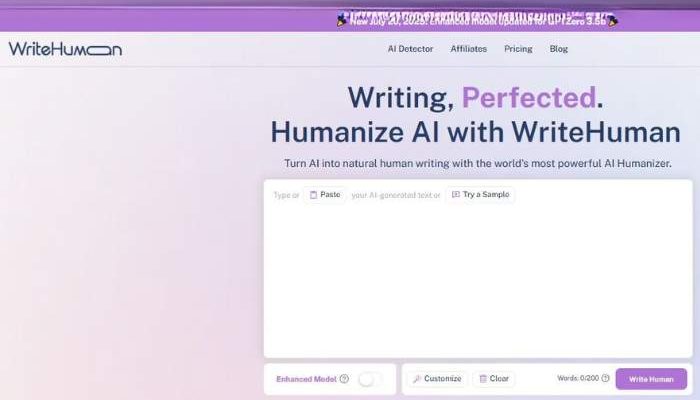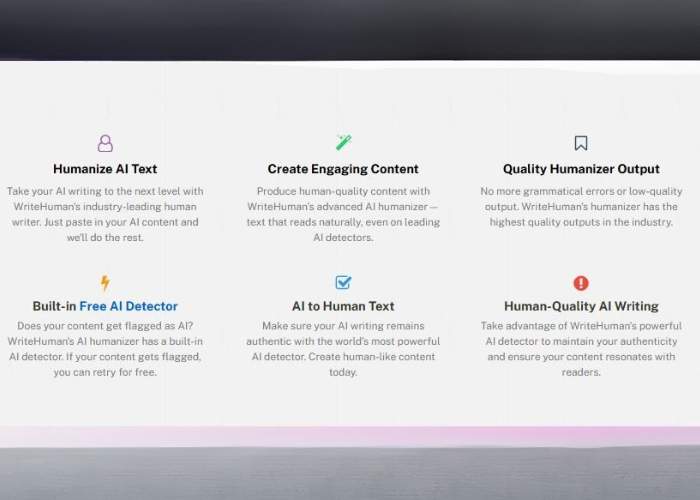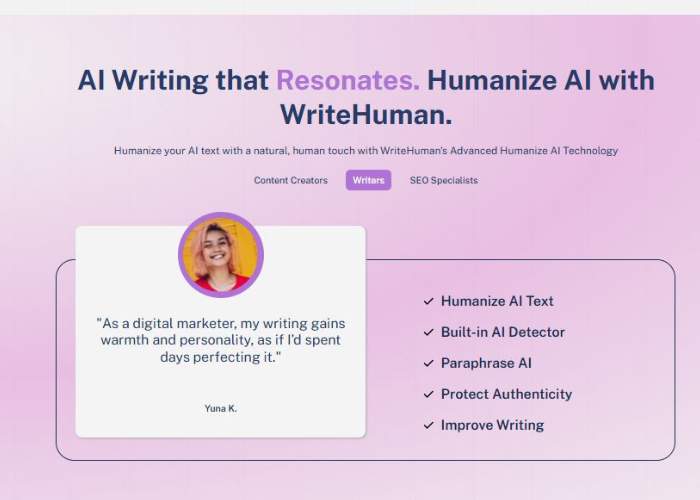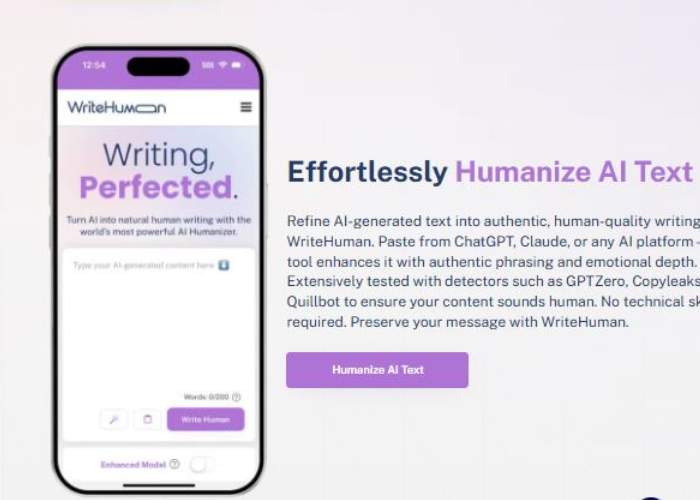
I Tested WriteHuman: Some Features Surprised Me
There’s this weird moment when you run your own writing through an AI detector and it comes back saying: “Yeah, this is probably written by AI.”
Cue the existential crisis.
I mean, I wrote it. With my own two hands. My own scatterbrained thoughts. My metaphors. My typos. Still flagged.
That was the moment I started looking into tools that do the opposite of what most AI detectors do — not tools that out AI writing, but ones that try to make it sound human. Less… robotic. Less suspicious.
That’s where WriteHuman.ai waltzed in.
So I gave it a go, tested it in all kinds of scenarios — rushed blog posts, rewrites, SEO blurbs, emotionally confused personal essays — and came out of the other side with more opinions than I expected.
Let’s talk about it.
What Exactly Is WriteHuman.ai?
In short? It’s a tool that rewrites AI-generated content to make it sound more human.
But that’s a bit of an oversimplification. Because it’s not just a glorified synonym shuffler. It actually reshapes sentences, adds informal rhythm, tweaks tone, and tries to strip that weird, overly polished AI feel.
It’s a bridge, basically. Between soulless auto-generated content and the kind of writing that makes readers nod, smirk, or reread a line because it hit a little too close to home.
How I Tested It
This wasn’t some academic experiment. I didn’t wear a lab coat. But I did throw a bunch of different content types at WriteHuman to see how it handled the challenge. Here’s the chaos I threw at it:
- Straight-up ChatGPT content (default tone)
- Overly edited SEO copy
- A heartfelt newsletter I wrote at 2am
- College-style essays
- My journal entry about a very specific kind of sadness you get on rainy Sundays
And yes, I ran both the before and after versions through AI detectors like GPTZero, Originality.ai, and Phrasly to see if the rewritten content passed the “smell test.”
Let’s look at the results.
Results Snapshot
| Input Type | Original AI Detection | After WriteHuman | Verdict |
| GPT-4 Blog Draft | 95% AI | 22% AI | Huge improvement |
| SEO Product Description | 89% AI | 35% AI | More natural, still a little stiff |
| Emotional Essay | 28% AI (falsely) | 7% AI | Helped tone down the “polish” |
| College-style Essay | 76% AI | 30% AI | Better, but academic tone lingered |
| Stream-of-consciousness journal | 14% AI | 11% AI | Barely needed edits — still helped |
I’ll say this much: it works. Not always perfectly, but in most cases it made the content less detectable, and often more readable. That’s a win in my book.
The Interface: Clean, Simple, Doesn’t Yell at You
First off, I appreciate a tool that doesn’t try to gamify every click. No neon progress bars or fake confetti after processing a paragraph. Just a clean, straightforward interface.
You paste your text in. It rewrites it in a few seconds. No drama. No login wall (until you hit limits). No condescending tooltips reminding you how AI works.
The UX feels designed for real working writers, not just tech bros testing language models.
What Does It Actually Change?
This is where it got interesting.
WriteHuman doesn’t just reword stuff. It does things like:
- Shortens or lengthens sentences to make rhythm more natural
- Adds contractions, idioms, and informal transitions
- Breaks up robotic lists or removes overly structured phrasing
- Occasionally throws in colloquialisms or a slightly sassy tone (loved that)
It’s subtle. But it matters.
Here’s a little side-by-side to show you what I mean:
Before & After Example
| Original GPT-Generated Text | WriteHuman Rewritten Text |
| “Implementing a consistent morning routine can significantly improve productivity and mental clarity.” | “Having a steady morning routine? It seriously helps you stay sharp and get more done.” |
| “Our platform utilizes cutting-edge machine learning to streamline workflows.” | “We use smart tech to make your work way easier.” |
The rewritten versions feel less like they were generated by a corporate chatbot and more like something your smart friend might say.
Weak Spots? Yeah, a Few.
It’s not all sunshine and emotionally resonant copy.
Sometimes, WriteHuman plays it a little too safe. Especially on more nuanced or poetic writing, it can accidentally flatten a sentence that had real voice. Or dumb it down slightly, losing a bit of nuance.
And if you’re writing something with a strong opinionated edge — satire, sarcasm, intense emotion — it might not fully get the vibe. You’ll have to do some touch-ups yourself. But that’s okay. I don’t want it to do everything for me.
Also, it doesn’t offer tone customization yet. Would be great to have sliders like “make this funnier,” or “add Gen Z energy,” or “tone down the robot CEO.”
Feature Breakdown
| Feature | Score (out of 5) | Notes |
| Rewrite Quality | ⭐⭐⭐⭐☆ (4.4) | Best for web content, casual tone, and edits |
| Detection Evasion | ⭐⭐⭐⭐☆ (4.5) | Drastically lowers AI scores in most cases |
| User Interface | ⭐⭐⭐⭐⭐ (5) | Fast, clean, intuitive |
| Emotional Awareness | ⭐⭐⭐☆ (3.5) | Struggles with poetic or deeply emotional content |
| Creative Writing Handling | ⭐⭐☆☆☆ (2.5) | Not made for fiction or lyrical stuff |
| Speed | ⭐⭐⭐⭐⭐ (5) | Blazing fast |
| Pricing | ⭐⭐⭐⭐☆ (4) | Reasonable credit model, could use more flexibility |

So Who’s It Actually For?
✅ Great for:
- SEO writers tired of sounding like a Roomba
- Freelancers trying to dodge AI detection without losing voice
- Agencies managing dozens of AI-assisted content drafts
- Students giving their “research” a human polish
- Anyone tired of ChatGPT’s default tone
❌ Not ideal for:
- Poets, screenwriters, or novelists
- Creatives who like their weird sentence structures
- People hoping to turn garbage into gold without effort
Final Thoughts: It’s Not Magic, But It Feels Like a Shortcut to Believability
There’s something oddly reassuring about using a tool called WriteHuman in 2025. Like it’s acknowledging the elephant in the room — yeah, we all use AI sometimes. So what? Doesn’t mean we’re lazy. Doesn’t mean we don’t care.
What does matter is how the writing lands. Does it sound real? Does it feel real?
That’s the line WriteHuman tries to walk. And most of the time, it stays on track. It’s not replacing your brain. It’s just helping you sidestep that awkward moment when your polished, well-structured paragraph gets flagged by some algorithm because it’s “too good to be human.”
Honestly, I’ll keep using it. Not because it writes for me. But because it rescues me when I start sounding like a spreadsheet with a thesaurus.
| Category | Verdict |
| Usefulness | High for web/content writing |
| AI Detection Avoidance | Strong improvement |
| Voice Preservation | Solid, but needs fine-tuning sometimes |
| Creative Support | Weak for poetic/fiction work |
| Value for Price | Worth it if you’re writing often |
| Overall Vibe | Honest, effective, and surprisingly human |
If you’re riding the line between AI assistance and authentic voice — and you don’t want to sound like you just copied ChatGPT verbatim — WriteHuman.ai is a tool worth having in your corner.
Just remember: a tool is only as human as the hand guiding it. And if you’re still asking “does this sound like me?”, that means you care. That’s what separates us from the bots.
Well, that and the fact we occasionally forget how to spell “definitely.”























